By
Chris Bauserman
|
Date Published: July 03, 2019 - Last Updated September 08, 2020
|
Comments
In our digital era, it seems each day brings a new way to connect and
communicate. From the proliferation of text, chat, and messaging apps like
Facebook and WhatsApp, today’s consumers expect to interact with companies
via a variety of digital channels, in addition to voice. It isn’t enough,
however, to simply offer these channels – they need to work together in a
single, seamless ecosystem where movement between channels is effortless.

Bridging that gap and achieving true digital-first omnichannel
functionality is a top priority for organizations today. In fact, according
to the most recent
NICE inContact CX Transformation Benchmark study
, 91 percent of customers expect seamless transitions between channels, but
only 24 percent of businesses give themselves an excellent rating on doing
so. What’s important to realize is that achieving true omnichannel service
doesn’t just require omnichannel tools – it requires omnichannel agents. In
many cases, agents operate in silos based on their skills, with a majority
dedicated to voice and a smaller number assigned to chat and social,
leaving only a handful who are truly omnichannel. It’s a significant
roadblock given the impending and inevitable standard of digital-first.
As you pursue a holistic, digital-first omnichannel strategy for your
agents and help them better meet customers where they are, here are tips to
get started:
Shift Culture, Expectations and Career Paths
On paper, omnichannel functionality elevates the agent experience. It
provides a single through-line to follow a customer through multiple
channels and proactively push them towards whichever one will resolve the
issue fastest. It’s a must for contact centers as well, given that 94
percent of customers expect companies to direct them to the fastest method
of contact.
However, as contact centers have evolved and added new channels, there’s
been a gap between the idea of omnichannel, and the practicalities of
embracing it on the agent level. For example, voice has remained among the
most relied upon channel for contact centers, so staffing has revolved
around that. Emerging channels, however, require different skills such as
balancing workflows between real-time responses and those that can be
asynchronous, like text or social messaging apps. This gap has been further
compounded by a lack of integration between new and old channels, making it
more difficult for agents to expand their skillsets. As a result, agents
flock towards the channels they’re comfortable with so they have maximum
control over their workflows and ability to achieve KPIs.
Overcoming these challenges requires changing the perception around what a
unified and complete cloud omnichannel platform can do for the agent
experience and emphasizing corresponding culture and incentives. Agents
will embrace being skilled as true omnichannel when contact centers provide
the right training, tools and expectation setting for all agents to be
digital-first omnichannel. It is also very important that this includes a
transition to modern KPIs that go beyond voice-centric measures like
average handle time (AHT).
Provide the Right Tools to For Agent Change Management
Getting agents proficient and excited about digital omnichannel service
requires the right toolkit to support your change management programs. If
the agent experience is clunky, frustrating or not designed with the
customer in mind, it will cause a backlash from your team. They need to
break out of digital silos, balancing real-time channels like voice and
chat with digital messaging interactions, all without sacrificing control
and context.
To make this transition, empower all your agents to deliver a true
digital-first omnichannel customer experience by simultaneously combining
all customer interactions in one intelligent inbox across multiple digital
channels and voice for agents to select ("pull"), while dynamically
prioritizing the most time-sensitive or real-time interactions according to
service levels and prevent cherry-picking ("push"). This dynamic control
keeps agents “in the zone” when moving between customers or channel types.
To help your agents manage this context switching make sure to provide a
real-time customer card with the essential just-in-time context agents need
for each interaction full customer context, journey history, and sentiment.
If You Build It, They Will Come
Modern contact centers have their own “chicken or the egg” dilemma. In this
case, it’s the traffic versus the channel: do contact centers proactively
integrate new and emerging channels into the mix or do they wait until
overwhelming customer demand warrants investment? The latter wait-and-see
approach reflects an outdated perspective on how brands and their agents
can and should be supporting today’s customers.
Contact center agents, first and foremost, need to be where their customers
are – chat, text and messaging apps. The CX Transformation Benchmark
consumer study found that U.S. consumer preference for using text for
customer service was up 71 percent from 2017 to 2018. In fact,
one contact center
saw this firsthand, for when they started offering text, the demand was
already there and text messages started streaming into the contact center.
There’s an added benefit to agents, too, as many are comfortable with these
channels in their personal lives as consumers. Transforming to a
digital-first contact center environment can be jump-started by leaning
into the skills agents already have and putting them to work for the
customer.
Race to Digital-first
Digital-first omnichannel experiences are increasingly a core expectation
for customers. In that, there’s an opportunity today to lead change
management for your agents and get them invested in its success. Partnering
with them to achieve this gives them skin in the game towards their own
career growth, engagement and job satisfaction.
Ultimately, achieving true omnichannel functionality requires a
three-pronged approach. First, recruiting, training and developing a staff
that is as comfortable communicating in and moving between channels as
customers are. Second, adopting the right intelligent, digital-first
customer experience platform to make it a reality. And third, make sure to
offer service on all the channels where your
customers are.